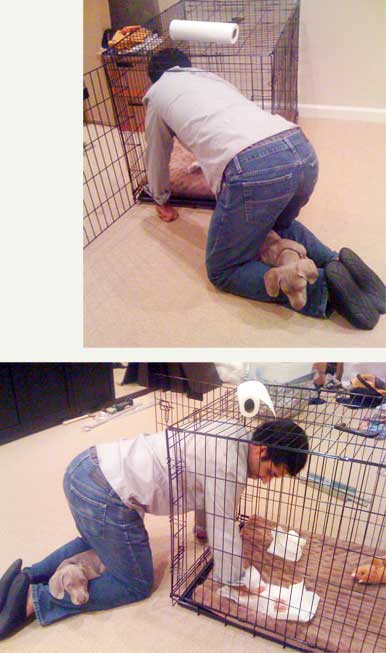
This site hasn’t been updated since 2012. You can still peruse who I was back then, but know that much of what I think, feel, write, and do has changed. I still occassionally take on interesting projects/clients, so feel free to reach out if that’s what brought you here. — Nishant
I'm one of the gullible masses that got suckered into Weimaraner obsession by William Wegman's evil photography portfolio. I knew I wanted one the moment I saw his first photograph. And, Dean Allen's The Daily Oliver certainly didn't help rescue me from my impending addiction.
As it turns out, pictures speak a thousand words, but the resultant prose is often deceiving. Even though it looks exactly like one, the Weimaraner often feels like it's not a breed of dog and instead more like a gifted child… with special needs.
This article is about coping with one common special need of Weimaraners—separation anxiety
Despite the prevailing stereotype, it's worth noting that Weimaraners are not anxious. They're sensitive. It is true that often exude anxious behavior, but this is usually a symptom of their sensitive natures. This is a very subtle, but important distinction that defines the ability of a human to understand the umwelt of a Weimaraner and subsequently be a good owner.

A common manifestation of sensitivity in Weims is separation anxiety—this is when your dog feels so abandoned when left home alone that he resorts to externally and intrinsically destructive behavior. Interestingly, if you google the term "separation anxiety", you'll find hundreds of articles about how it manifests in human children and how to get your child past it. Indeed, separation anxiety is a common human disorder and it manifests in a very similar way in canines.
The key to treating separation anxiety in a Weimaraner is that there is no master key. You can't pull theories out of a book or regurgitated by experts and expect them to solve the problem.
Let me offer up our own experience to illustrate this point.
We would leave Yoshi at home in his crate (crate-training is a well-researched, and tried and tested methodology to raise dogs) when we were at work. It worked at first, but within a few weeks we started coming home to Yoshi covered in pee. We figured it was because he was still a puppy and had a small bladder, but we soon discovered what it really was.
One Saturday, we crated him a few minutes after he'd relieved himself in the yard and then left the house to walk to a nearby coffee shop. We left him a chew toy and a pillow to distract him. But we had to turn back within a few minutes because we forgot something at home.

When we entered the room, we found Yoshi in a mess of feathers in the crate, covered in pee and barking. He was also shaking.
At this point, it became clear to us that Yoshi had a problem that was bigger than we had been willing to acknowledge (we later learned from some quick searches online that it was indeed separation anxiety). We stopped leaving him home alone and began taking him everywhere with us. I started taking him to work and when we went out, he'd come along and stick around in the car. We found that leaving him alone in the car didn't freak him out. He just climbed onto the driver seat and took a nap awaiting our return.
But as you can imagine, the liability of taking a Weimaraner everywhere with you can be both taxing and limiting. Our patience waning, we decided to bring home a behavioral expert. She concluded that we should get a smaller crate that confined him (the theoretical reason is that it makes the dog feel more secure), move it to another location in the house, and possibly cover it with a sheet so he feels even more secure.
Suffice to say, her advice proved to be as ridiculous as it first sounded to us. As a side-note, we have an extra dog crate if you need one.
What finally solved the separation anxiety problem is something that makes no sense when you consider dog behavior gospel. However, if you think of Yoshi as a human child with special needs, it makes perfect sense.
One day, Pita, my wife, somehow managed to convince me to leave Yoshi free at home while we were out. She'd been arguing for a while (from gut instinct) that Yoshi might be more open to such a situation. But with images of Weimaraners digging through drywall firmly plastered in my brain, this seemed like a preposterous idea to me. Nonetheless, I agreed to go along with it so long as I would be allowed to set up a nanny cam that would let us keep watch on him remotely.
We positioned the camera to give us the most encompassing view of the room. Then, we left our cats, Mango and Izzy at home to keep him company, and left the house with Pita frantically refreshing the iPhone browser window pointed at the webcam feed in the passenger seat as we drove away to a party.
What ensued was shocking, hysterical and a godsend.
First the animals walked single file into the kitchen looking for scraps of food; as a side note, simply by observing the ordering of the line, we finally learned that Izzy is at the top of the food chain, while Yoshi, unsurprisingly, is at the bottom. So much for Weims having "prey instinct" (another generalized breed myth).

Next, they all moved to the couch and each found a comfortable spot on it. It was clear that Yoshi was showing pack behavior; it just so happened that the other two creatures were cats that were mentally stable and served as good role models.
For the next hour or so, they alternated between taking naps and wandering around the house looking for trouble. Finally, Yoshi settled down on the couch next to Mango and slept for almost four hours, only waking up to shift positions.
Yes, it was the first time we'd left him alone at home in almost a year. And our methods flew in the face of everything we'd read and heard from experts. We didn't crate him. We didn't leave him any chew toys. And we certainly didn't ease him into getting comfortable with being alone.
Today, Yoshi is almost perfectly behaved when left home alone, spare the occasional bout of gutting a cushion—not any ol' cushion, but one specific cushion that we've dubbed the "decoy pillow". We re-stuff it whenever we come back home and replace it for future Weim use. We're convinced that this minor destructive behavior isn't separation anxiety as much as it's him throwing a tantrum (we've even caught it on camera—he guts the pillow and then takes a long nap in the foamy mess he created). Every so often, he'll go find a shoe, strategically place it on the couch, and then proceed to take a nap next to it.
Whenever we come home to such delinquent behavior, we find him peeking out from under the dining table (he's very good at punishing himself) waiting to see how we respond to his silent threat involving the abducted shoe.

Weimaraners are the kind of dogs that stare intently into your eyes not only as you speak to them, but also when you're not talking. They exude a longing to understand their human companions, and our commitment to discard this sensitivity as our own anthropomorphic flaw seems more like a classic example of confirmation bias to me than anything else.
Most of Yoshi's behavioral problems seemed to disappear overnight the moment we approached solutions that factored in his sensitive and perceptive nature.
So, if your dog is suffering from separation anxiety and the textbooks haven't been helping, then you may be oversimplifying the problem at hand.
It may just be that your canine needs treatment more fitting of man's best friend.
comments powered by Disqus